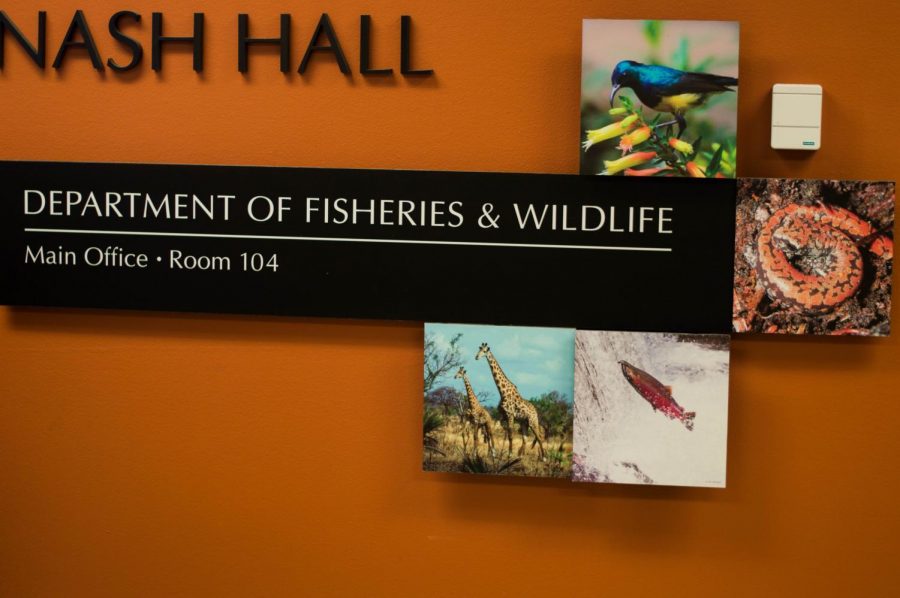Genetic differences
March 29, 2016
Study finds difference in genes between wild and hatchery fish
Steelhead salmon raised in hatcheries are less likely to thrive in the wild because their genes are altered by being in captivity, according to a recent, six-year study by Oregon State University researchers.
“There’s evidence that hatchery fish negatively impact the wild fish population,” said Michael Blouin, a biology professor at OSU who helped author the study, published Feb. 17. “However, the mechanism is unclear.”
According to Blouin, the way he and his team found out that captivity alters the genes in steelhead was by using a series of crosses with one hatchery male, one wild male, one hatchery female and one wild female. The results were that 723 genes were significantly differently expressed between offspring of two wild fish and two hatchery fish, Blouin said.
“Genes that affect metabolism are affected,” Blouin said. “Also, genes that affect wound repair and immune function are affected. We looked at the expression, which is the activity level of each offspring’s genomes.”
According to Blouin, the team of researchers and scientists used a common environment, so the environment could not be a factor in the findings.
Since these genes are affected in Steelhead offspring, a hypothesis can be confirmed, Blouin said. “Selective pressures of hatcheries by crowding 50,000 fish in a small box alter these genes.”
“We’ve known for quite a few years now that hatchery fish perform worse in the wild,” Blouin said. “There’s evidence that this has been genetic for steelhead. There’s evidence that there is a genetically based difference because of captivity. Therefore, we want to know what traits are under selection in hatcheries, and what conditions in hatcheries cause those strong selection pressures.”
Brooke Penaluna, a research fish biologist with the PNW Research Station with the US Forest Service, said the study found connections between captivity and genetics.
“This was the first study that proposed an underlying reason for (hatchery and wild fish population) differences in characteristics, attributes, behaviors, and genetics,” Penaluna said. “It’s due to adaptation to captivity. Within one generation, those being held in hatcheries adapted to the captive environment.”
Kate Self, an OSU graduate student that works with Blouin, said the salman are key factors in the ecosystem.
“(Steelhead) have been here a long time,” said Self, “They are a really heavy player in our global ecosystem—they bring back marine-derived nutrients as adults when they come back to spawn and die. The eggs that they lay—less than one-half of 1 percent—will return as adults, so the rest of those eggs and juvenile fish go to feeding and adding nutrients to the system.”
Self stated the fish are also important to the citizens of Oregon as well.
“(Steelhead) are a huge cornerstone to many of our people in Oregon,” Self said. “Also, a lot of us, in general, in the Pacific Northwest strongly identify with the salmon as a symbol of a healthy ecosystem. They are also important for angling and recreational opportunities.”
According to Self, the goal of the study was to help undo what we as humans did, for example, overfishing, polluting, logging, and barricading paths for fish migration, such as building dams.
“The whole point of our project is to get salmon runs back to a healthy level,” Self said. “The levels of steelhead vary in different areas, so there aren’t specific numbers, but we want enough fishes so that they won’t be threatened or endangered anymore because they matter culturally, economically, and intrinsically to people.”
According to Boulin, expertss now agree that salmon from hatcheries vary genetically from their wild counterparts.
“Most scientists are now in agreement that hatchery fish are genetically different than wild fish,” Blouin said. “There is little evidence that hatcheries that exist to supplement the wild fish population help the wild fish population.”
According to Bruce McIntosh, who oversees all of the fish hatchery programs for the Oregon Department of Fish and Wildlife (ODFW), 32 hatcheries across Oregon produce roughly 5 million Steelhead salmon consistently each year as a whole and will do so for the foreseeable future.
ODFW’s mission is insuring that their wild fish stocks are eternally sustainable under Oregon law, McIntosh said.
“It’s great work,” McIntosh said of Blouin’s study. “We have a long involvement with Dr. Blouin. The underpinning of his research for the last decade or so has been through our facilities and through our people.”
According to McIntosh, they’ve helped fund this study.
“Now we’ve described these differences between hatchery and wild fish, and what their effects are, so what about the hatchery creates that situation?” McIntosh said. “What can we do to reduce or eliminate those risks?”
Studies involving Blouin set out to answer those questions, which appears to be related to the density of fishes in hatcheries, are currently ongoing and are continually funded by the ODFW, McIntosh said.
According to Penaluna, this study has broad applications since hatcheries are used throughout North America.
“This study shows that we need to rethink our hatchery designs if we want hatcheries to supplement wild fish populations,” Penaluna said.
“We’re always looking for ways to reduce the impact of hatchery fish on wild fish and to put those practices into place, and we’ll continue to do that,” McIntosh said.











































































































